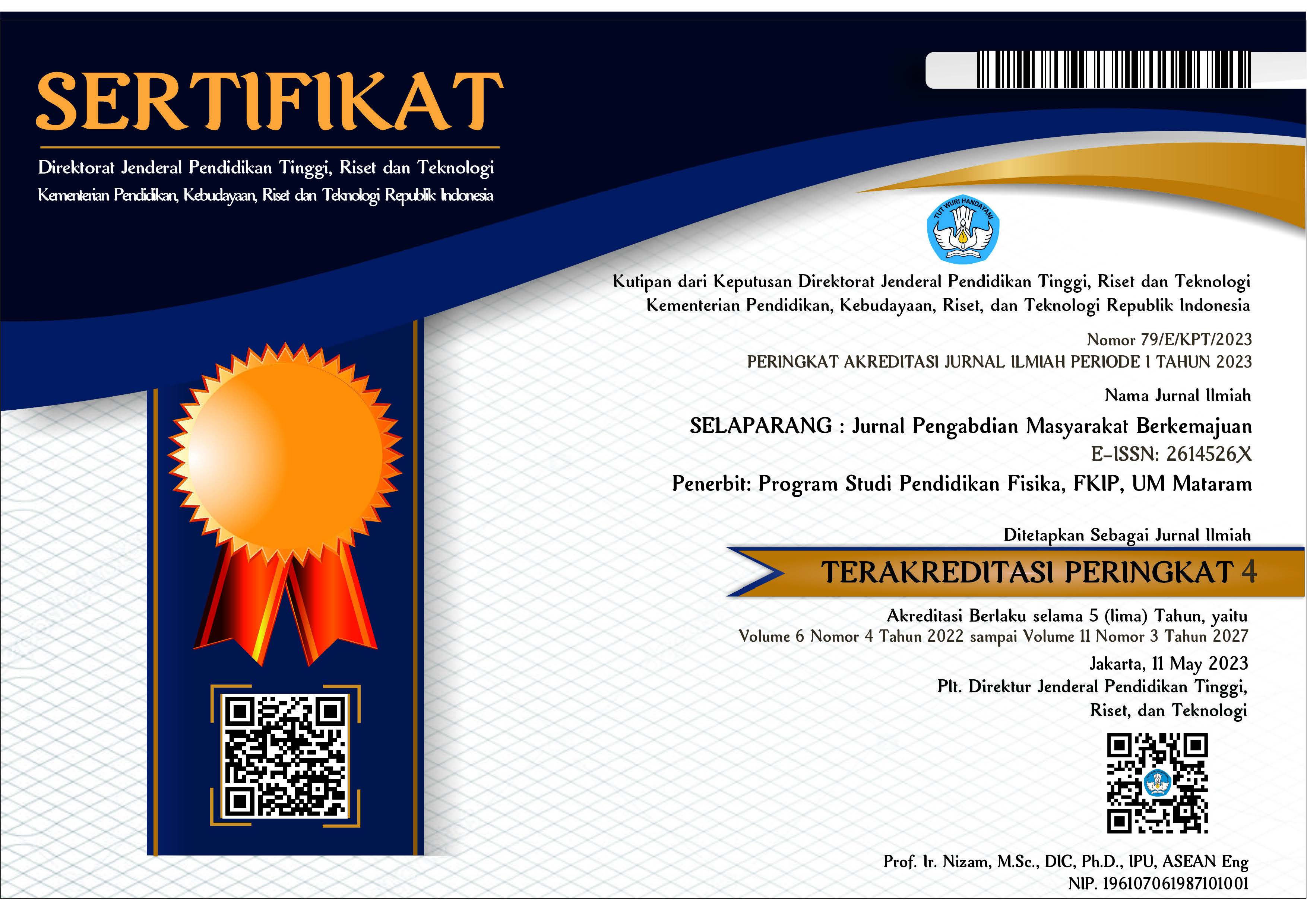PENDAMPINGAN PRODUKSI PESTISIDA NABATI PADA PETANI HORTIKULTURA DI DESA SUKORAMBI KABUPATEN JEMBER
Abstract
ABSTRAK
Desa Sukorambi adalah salah satu desa sentra produk hortikultura di Kabupaten Jember. Permasalahan yang dihadapi adalah ketergantungan penggunaan pestisida sintetis. Tujuan dari pengabdian masyarakat adalah mengenalkan pestisida nabati sebagai alternatif pengganti pestisida sintetis dan menurunkan residu pestisida pada produk hortikultur. Pengabdian ini dilakukan di Desa Sukorambi, Kecamatan Sukorambi, Kabupaten Jember. Metode pelaksanaan terdiri dari FGD (Focus Group Discussion) dan praktek produksi dan aplikasi pestisida nabati. Hasil pengabdian menunjukkan bahwa ada peningkatakan pengetahuan dan keterampilan petani dalam produksi pestisida nabati baik secara mandiri maupun kelompok. Forum diskusi terbagi menjadi dua sesi, yaitu pemaparan materi dan tanya jawab pelaksana dengan petani. Untuk aplikasi di lahan, petani diberikan penjelasan mengenai teknik aplikasi dan kalibrasi. Kemudian petani melakukan aplikasi pestisida pada lahan tanaman bayam. Kesimpulan dari pengabdian ini adalah wawasan dan keterampilan petani terkait dengan pestisida nabati semakin meningkat. Diharapkan mampu memproduksi masal pestisida nabati untuk mengurangi ketergantungan terhadap pestisida sintetis dan mengurangi residu pestisida.
Kata kunci: berkelanjutan; hortikultura; pemberdayaan; produksi; residu.
ABSTRACT
Sukorambi Village is one of the centers for horticultural products in Jember Regency. The main problem is dependence on the use of synthetic pesticides. The purpose of community service is to introduce botanical pesticides as an alternative and reduce pesticide residues in horticultural crops. This service is carried out in Sukorambi Village, Sukorambi District, Jember Regency. The implementation method consists of FGD (Focus Group Discussion) and production practices and application of botanical pesticides. The results of the service show that there is an increase in the knowledge and skills of farmers in the production of bpotanical pesticides, both independently and in groups. The discussion forum was divided into two sessions, namely the presentation of the material and the question and answer session with the farmers. For applications in the field, farmers are given an explanation of the application and calibration techniques. Then the farmers applied pesticides to the spinach plantations. The conclusion of this service is that the insight and skills of farmers related to botanical pesticides are increasing. It is expected to be able to mass produce botanical pesticides to reduce dependence on and reduce pesticide residues.
Keywords: sustainable; horticulture; empowerment; production; residue.
Keywords
Full Text:
PDFReferences
Amilia, E., Joy, B., Sunardi. (2016). Residu Pestisida pada Tanaman Hortikultura (Studi Kasus di Desa Cihanjuang Rahayu Kecamatan Parongpong Kabupaten Bandung Barat). Jurnal Agrikultura, 27(1), 23–29.
Hoesain, M., Prastowo, S., Suharto, Pradana, A. P., Asyiah, I. N., Alfarisy, F. K., & Adiwena, M. (2021). Combination of plant growth-promoting bacteria and botanical pesticide increases organic red rice yield and reduces the leptocorisa acuta population. Biodiversitas, 22(4), 1686–1694. https://doi.org/10.13057/biodiv/d220411
Hoesain, M., Prastowo, S., Wagiyana, Pradana, A. P., Alfarisy, F. K., & Adiwena, M. (2021). Use of aqueous plant extracts to reduce profenofos residues in the leaf of mustard (Brassica juncea L.) and suppression of the grasshopper population. Plant Science Today, 8(3), 674–680. https://doi.org/10.14719/PST.2021.8.3.1173
Hoesain, M., S. Winarso, A. F. Sunartomo dan F. K. Alfarisy. (2020). Strategi Pengembangan Usaha Tani Melalui Penerapan SNI 6729-2016 Sebagai Upaya Peningkatan Petani Padi Organik. Dharmakarya Journal, 9(3): 149-152.
Krisna, K. N. P., Yusnaeni, Y., Lika, A. G., & Sudirman, S. (2022). Uji Efektivitas Ekstrak Daun Bandotan (Ageratum conyzoides) sebagai Biopestisida Hama Ulat Buah (Helicoverpa armigera). EduBiologia: Biological Science and Education Journal, 2(1), 35. https://doi.org/10.30998/edubiologia.v2i1.10541.
Sari, N., A. Fatachya, P., Tjitropranoto. (2016). Tingkat Penerapan Pengendalian Hama Terpadu (PHT) Sayuran di Kenagarian Koto Tinggi, Kabupaten Agam, Sumatera Barat. Jurnal Penyuluhan, 16(1): 15-30.
Silalahi, M. (2018). Ageratum conyzoides L. (Pemanfaatan Sebagai Obat Dan Bioaktivitasnya). JDP, 11(3): 197-209.
Singkoh, M. F. O., dan Katili, D. Y., Bahaya Pestisida Sintetik (Sosialisasi Dan Pelatihan Bagi Wanita Kaum Ibu Desa Koka Kecamatan Tombulu Kabupaten Minahasa). Jurnal Perempuan dan Anak Indonesia, 1(1):5-12.
Tuhumury, G. N. C., J. A. Leatemia, R. Y. Rumthe, dan J.V. Hasinu. (2012). Residu Pestisida Produk Sayuran di Kota Ambon. Agrologia, 1(2): 99-105.
Wibawa, I. P. A. H. (2019). Uji Efektivitas Ekstrak Mimba (Azadirachta indica A. Juss.) untuk Mengendalikan Hama Penggerek Daun pada Tanaman Podocarpus neriifolius. E-Jurnal Agroekoteknologi Tropika, 8(1): 20-31.
Wiratno, Siswanto, dan I. M. Trisawa. (2013). Perkembangan Penelitian, Formulasi, Dan Pemanfaatan Pestisida Nabati. Litbang Pertanian, 32(4): 150-155.
Wulandari, E., A. K. Liza, dan M. Ridwan. Pestisida Nabati Pembasmi Hama Ramah Lingkungan Untuk Petani Tebuwung. Jurnal Abdikarya, 3(4): 352-257.
Yuantari, M. G. C., B. Widiarnoko, dan H. R. Sunoko. (2015). Analisis Risiko Pajanan Pestisida Terhadap Kesehatan PetanI. Jurnal Kesehatan Masyarakat, 10(2): 239-245.
DOI: https://doi.org/10.31764/jpmb.v6i2.7999
Refbacks
- There are currently no refbacks.

This work is licensed under a Creative Commons Attribution-ShareAlike 4.0 International License.
______________________________________________________
Jurnal Selaparang
p-ISSN 2614-5251 || e-ISSN 2614-526X
EDITORIAL OFFICE:



















